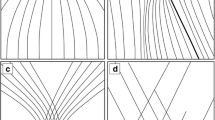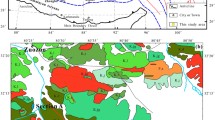Summary
The orientations of joints were measured in the region of Guadeloupe (French West Indies) early in 1979. This island consists of a calcareous region (Grande-Terre) and of a volcanic region (Basse-Terre); a group of small islands (Iles des Saintes) to the South is also volcanic. The preferred orientations of the joints were then calculated for each region by the statistical method of Kohlbeck and Scheidegger. It is seen that the preferred joint-orientations on Grande-Terre and the Iles des Saintes agree with those found on the Bahamas and on Barbados. The joints on Basse-Terre are turned by about 45o in comparison with those on Grande-Terre. The joint-orientations on Grande-Terre, Barbados and the Bahamas fit well together with the notions derived from plate tectonic theory (essentially a relative EW displacement between the American and Caribbean Plates); the origin of the anomaly on Basse-Terre is not yet understood.
Zusammenfassung
Im Jahre 1979 wurden Kluftstellungen in der Region von Guadeloupe (französische Antillen) gemessen. Guadeloupe besteht zum einen Teil aus Kalk (Grande-Terre), zum anderen aus vulkanischem Material (Basse-Terre). Eine Gruppe von kleineren Inseln im Süden (Iles des Saintes) ist ebenfalls vulkanisch. Die bevorzugten Kluftstellungen wurden für jede Region nach der statistischen Methode von Kohlbeck und Scheidegger berechnet. Man erkennt dann, daß die bevorzugten Kluftstellungen von Grande-Terre mit denen in Barbados und auf den Bahamas übereinstimmen. Die Klüfte in Basse-Terre sind um etwa 45o mit Bezug auf diejenigen in Grande-Terre verdreht. Die Kluftstellungen in Grande Terre, Barbados und den Bahamas stimmen sehr gut mit den Postulaten der Plattentektonik der Karibik überein (eine relative EW-Bewegung zwischen der amerikanischen und karibischen Platte) die Ursache der Anomalie in Basse-Terre ist noch nicht geklärt.
Résumé
Les orientations des diaclases ont été mesurées en Guadeloupe (Antilles Françaises). Cette ile est constituée d'une région calcaire (Grande-Terre) et d'une région volcanique (Basse-Terre); un groupe de petites iles (Iles de Saintes) au Sud est également volcanique. Les orientations préférentielles des diaclases ont été calculées pour chaque région avec la méthode statistique de Kohlbeck et Scheidegger. Il apparait que les orientations préférentielles des diaclases en Grande-Terre et aux Iles des Saintes sont comparables à celles trouvées aux Bahamas et à Barbade. Les diaclases de Basse-Terre ont subi une rotation de 45° par rapport à celles de Grande-Terre. Les orientations des diaclases en Grande-Terre, Barbade et aux Bahamas correspondent très bien avec les notions dérivées de la tectonique des plaques (essentiellement un déplacement relatif EW entre les plaques de l'Amérique et Caraibe), l'origine de l'anomalie en Basse-Terre n'est pas encore comprise.
Similar content being viewed by others
References
Fink, L. K.: Geology of the Guadeloupe Region, Lesser Antilles Island Arc. 122 p. Ph. D. Thesis, University of Miami, Florida, 1968.
Kohlbeck, F., Scheidegger, A. E.: On the Theory of Joint Orientation Measurements. Rock Mech.9, 9–25 (1977).
Reynal de St. Michel, A.: Carte géologique détaillé de La France, “Feuilles de Basse-Terre et des Saintes”, et “Notice Explicative”; 2 cartes+60 pp. Paris, Ministère de l'Industrie, 1966.
Scheidegger, A. E.: The Tectonic Significance of Joints in the Canary Islands. Rock Mech.11, 69–85 (1978).
Scheidegger, A. E.: Joints in Eastern North America and Their Geotectonic Significance. Arch. Met. Geoph. Biokl., Ser. A27, 375–380 (1978).
Author information
Authors and Affiliations
Additional information
With 6 Figures
Rights and permissions
About this article
Cite this article
Bonneton, J.R., Scheidegger, A.E. Joints on Guadeloupe and their geotectonic significance. Arch. Met. Geoph. Biokl. A. 29, 397–409 (1980). https://doi.org/10.1007/BF02245436
Received:
Issue Date:
DOI: https://doi.org/10.1007/BF02245436




